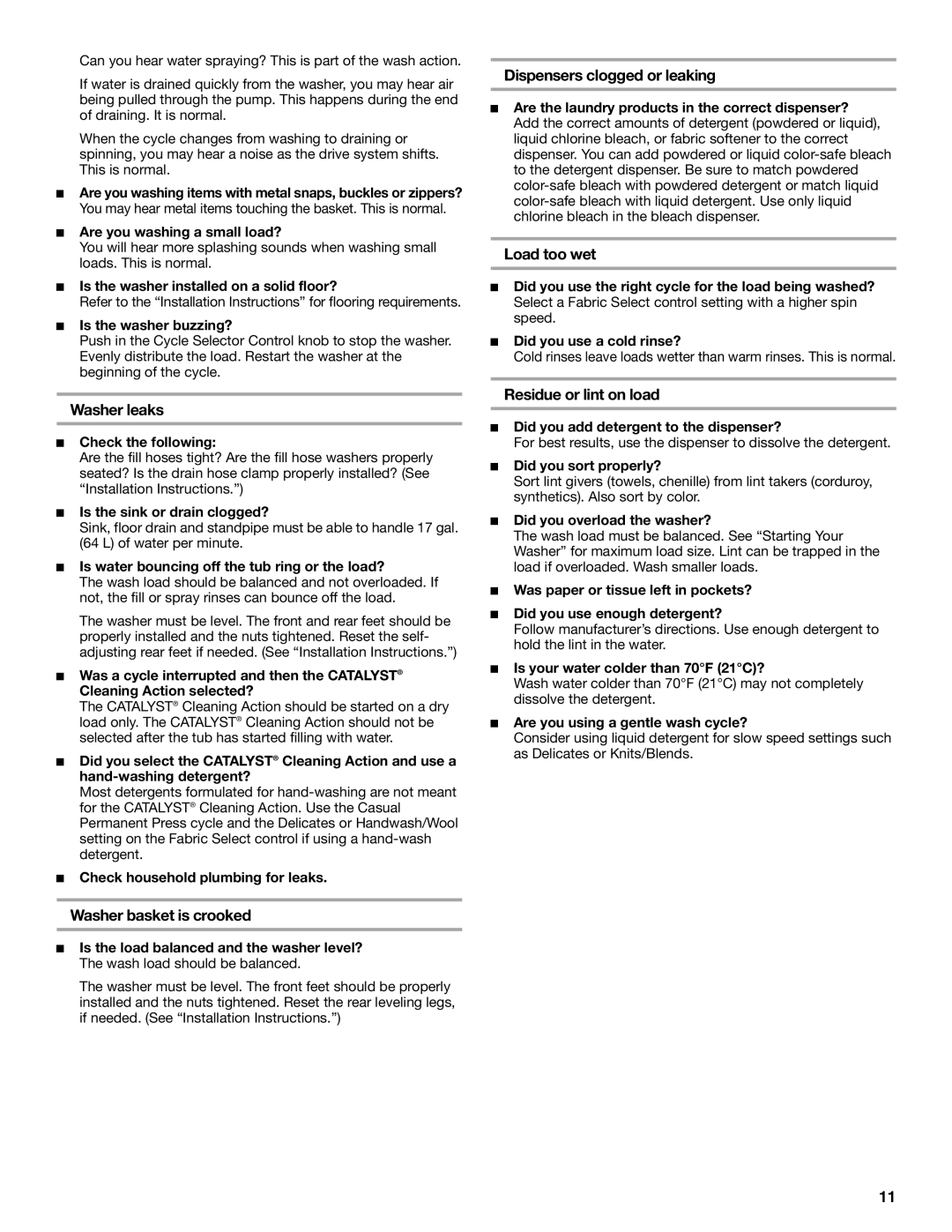
Can you hear water spraying? This is part of the wash action.
If water is drained quickly from the washer, you may hear air being pulled through the pump. This happens during the end of draining. It is normal.
When the cycle changes from washing to draining or spinning, you may hear a noise as the drive system shifts. This is normal.
■Are you washing items with metal snaps, buckles or zippers? You may hear metal items touching the basket. This is normal.
■Are you washing a small load?
You will hear more splashing sounds when washing small loads. This is normal.
■Is the washer installed on a solid floor?
Refer to the “Installation Instructions” for flooring requirements.
■Is the washer buzzing?
Push in the Cycle Selector Control knob to stop the washer. Evenly distribute the load. Restart the washer at the beginning of the cycle.
Washer leaks
■Check the following:
Are the fill hoses tight? Are the fill hose washers properly seated? Is the drain hose clamp properly installed? (See “Installation Instructions.”)
■Is the sink or drain clogged?
Sink, floor drain and standpipe must be able to handle 17 gal. (64 L) of water per minute.
■Is water bouncing off the tub ring or the load?
The wash load should be balanced and not overloaded. If not, the fill or spray rinses can bounce off the load.
The washer must be level. The front and rear feet should be properly installed and the nuts tightened. Reset the self- adjusting rear feet if needed. (See “Installation Instructions.”)
■Was a cycle interrupted and then the CATALYST® Cleaning Action selected?
The CATALYST® Cleaning Action should be started on a dry load only. The CATALYST® Cleaning Action should not be selected after the tub has started filling with water.
■Did you select the CATALYST® Cleaning Action and use a
Most detergents formulated for
■Check household plumbing for leaks.
Washer basket is crooked
■Is the load balanced and the washer level? The wash load should be balanced.
The washer must be level. The front feet should be properly installed and the nuts tightened. Reset the rear leveling legs, if needed. (See “Installation Instructions.”)
Dispensers clogged or leaking
■Are the laundry products in the correct dispenser? Add the correct amounts of detergent (powdered or liquid), liquid chlorine bleach, or fabric softener to the correct dispenser. You can add powdered or liquid
Load too wet
■Did you use the right cycle for the load being washed? Select a Fabric Select control setting with a higher spin speed.
■Did you use a cold rinse?
Cold rinses leave loads wetter than warm rinses. This is normal.
Residue or lint on load
■Did you add detergent to the dispenser?
For best results, use the dispenser to dissolve the detergent.
■Did you sort properly?
Sort lint givers (towels, chenille) from lint takers (corduroy, synthetics). Also sort by color.
■Did you overload the washer?
The wash load must be balanced. See “Starting Your Washer” for maximum load size. Lint can be trapped in the load if overloaded. Wash smaller loads.
■Was paper or tissue left in pockets?
■Did you use enough detergent?
Follow manufacturer’s directions. Use enough detergent to hold the lint in the water.
■Is your water colder than 70°F (21°C)?
Wash water colder than 70°F (21°C) may not completely dissolve the detergent.
■Are you using a gentle wash cycle?
Consider using liquid detergent for slow speed settings such as Delicates or Knits/Blends.
11
